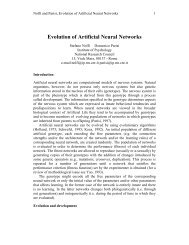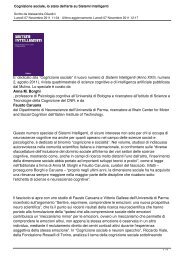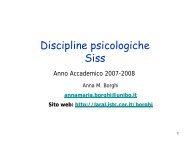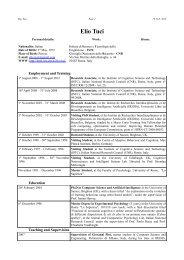Moving hands, moving entities. Annalisa Setti, Anna M ... - LARAL
Moving hands, moving entities. Annalisa Setti, Anna M ... - LARAL
Moving hands, moving entities. Annalisa Setti, Anna M ... - LARAL
You also want an ePaper? Increase the reach of your titles
YUMPU automatically turns print PDFs into web optimized ePapers that Google loves.
three way significant interaction between the three factors [F(2,88) = 3.95, MSe =<br />
0.688, p < 0.05]. The interactions between Type of Prime and Condition [F(2,88) =<br />
10.03, MSe = 8.16, p < 0.001], Condition x Type of Target [F(2,88) = 11.86, MSe =<br />
8.16, p < 0.001] and Type of Prime x Type of Target [F(1,44) = 27.5, MSe = 17.75, p <<br />
0.001] were also significant. A Post Hoc Newman-Keuls (p < 0.05) analysis was run<br />
on the Type of Prime x Condition x Type of Target interaction showing that targets<br />
referring to plants paired with a ‘Action only’ unimanual primes and targets referring<br />
to animals paired with the ‘Action+Motion’ bimanual primes lead to the highest<br />
number of errors and differed from all other conditions, while not differing from each<br />
other (M = 1.95; M = 1.78, respectively).<br />
Comparing the results on RTs and accuracy for animal targets with bi-manual<br />
primes, a speed-accuracy trade-off appeared as animal targets paired with bimanual<br />
‘Action+Motion’ primes were responded to faster leading to a higher number of<br />
errors than in the other conditions. Therefore, a further analysis taking into account<br />
the speed-accuracy trade-off was deemed necessary.<br />
Response times were divided by the proportion of correct responses (Chan,<br />
Merrifield, & Spence, 2005; Townsend, & Ashby, 1978) and entered in an ANOVA<br />
with Type of Prime as a between participants factor and Condition and Type of Target<br />
as within participants factors (same as above). As in the previous analyses the three<br />
way interaction was significant [F(2,88) = 9.84, MSE = 1.17, p < 0.001]. The<br />
interactions between Type of Prime x Type of Target [F(1,44) = 4.98, MSe = 1.49, p <<br />
0.05] and Type of Target x Condition [F(2,88) = 3.87, MSe = 4.62, p < 0.05] were<br />
also significant. As above we will discuss only the three way interaction.<br />
The Post Hoc Newman-Keuls (p < 0.05) analysis ran on the Type of Prime x<br />
Condition x Type of Target interaction showed a significant difference between RTs<br />
14















